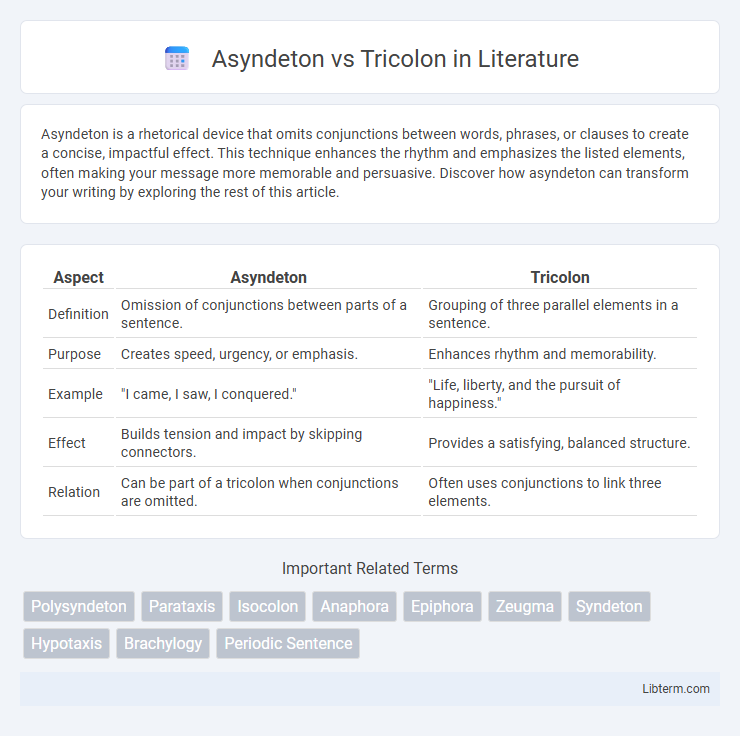Asyndeton is a rhetorical device that omits conjunctions between words, phrases, or clauses to create a concise, impactful effect. This technique enhances the rhythm and emphasizes the listed elements, often making your message more memorable and persuasive. Discover how asyndeton can transform your writing by exploring the rest of this article.
Table of Comparison
| Aspect | Asyndeton | Tricolon |
|---|---|---|
| Definition | Omission of conjunctions between parts of a sentence. | Grouping of three parallel elements in a sentence. |
| Purpose | Creates speed, urgency, or emphasis. | Enhances rhythm and memorability. |
| Example | "I came, I saw, I conquered." | "Life, liberty, and the pursuit of happiness." |
| Effect | Builds tension and impact by skipping connectors. | Provides a satisfying, balanced structure. |
| Relation | Can be part of a tricolon when conjunctions are omitted. | Often uses conjunctions to link three elements. |
Understanding Asyndeton: Definition and Usage
Asyndeton is a rhetorical device characterized by the deliberate omission of conjunctions between words, phrases, or clauses, creating a concise and impactful effect. It enhances the rhythm and urgency of the sentence by emphasizing each element equally, often found in speeches and literature to convey intensity. Understanding asyndeton helps identify its role in amplifying emotion, speeding up the narrative pace, and drawing attention to the listed items without the distraction of connecting words.
What is a Tricolon? Exploring Its Structure
A tricolon is a rhetorical device consisting of three parallel elements or phrases of equal length, often used to create rhythm and emphasis in speech or writing. Its structure relies on the balance and repetition of three clauses, enhancing persuasion and memorability. Unlike asyndeton, which omits conjunctions, tricolon emphasizes the power of three related components arranged sequentially to strengthen an argument or statement.
Key Differences Between Asyndeton and Tricolon
Asyndeton is a rhetorical device characterized by the deliberate omission of conjunctions between words, phrases, or clauses to create a concise and impactful effect, while tricolon refers to a series of three parallel elements that build rhythm and emphasis. The key difference lies in structure and intent: asyndeton removes connectors for speed and intensity, whereas tricolon uses the rule of three to enhance memorability and balance. Both techniques optimize sentence impact but serve distinct stylistic purposes in speech and writing.
Historical Origins of Asyndeton and Tricolon
Asyndeton traces its historical origins to classical Latin and Greek rhetoric, where it was used to create a rapid, impactful effect by omitting conjunctions between words or phrases. Tricolon, a technique rooted in ancient Roman and Greek literature, structures rhetoric with three parallel elements to produce rhythm and memorable emphasis. Both devices were extensively utilized by classical orators like Cicero and Shakespeare to enhance persuasion and stylistic power.
Effects on Rhythm and Emphasis in Writing
Asyndeton creates a rapid, staccato rhythm by omitting conjunctions, intensifying urgency and making each element stand out distinctly, thereby emphasizing the individual components in a list. Tricolon employs a rhythmic, balanced structure of three parallel elements, generating a sense of completeness and reinforcing key ideas through repetition and cadence. Together, these rhetorical devices manipulate pacing and emphasis, enhancing memorability and persuasive impact in writing.
Famous Literary Examples of Asyndeton
Asyndeton, a rhetorical device where conjunctions are deliberately omitted between phrases or words, is famously employed by Julius Caesar in the phrase "Veni, vidi, vici," showcasing concise and powerful impact. Shakespeare uses asyndeton to heighten dramatic tension in "Othello," as seen in the line "I kissed thee ere I killed thee," emphasizing emotional intensity by rapid, unconnected statements. Unlike tricolon, which involves a series of three parallel elements, asyndeton accelerates rhythm and creates a sense of urgency or immediacy through its omission of conjunctions.
Tricolon in Rhetoric: Power of Three
Tricolon in rhetoric harnesses the power of three parallel elements to create a memorable and persuasive effect, enhancing speech rhythm and emphasis. This technique engages listeners by structuring ideas in groups of three, which is naturally appealing and easy to process cognitively. Unlike asyndeton, which omits conjunctions for brevity and speed, tricolon relies on symmetry and repetition to reinforce arguments and evoke emotional responses.
When to Use Asyndeton vs. Tricolon
Asyndeton enhances impact and speed by omitting conjunctions in a series of words or phrases, making it ideal for creating urgency or emphasizing a list's intensity. Tricolon organizes ideas into three parallel elements, providing rhythm and balance, which is effective for persuasive writing or speeches requiring memorable structure. Use asyndeton when you want to generate a rapid, dynamic effect and tricolon when clarity, emphasis, and pattern are paramount for audience retention.
Common Mistakes and How to Avoid Them
Common mistakes in using asyndeton include overusing the technique, which can lead to a confusing or choppy rhythm, and failing to maintain clarity by omitting necessary conjunctions. In contrast, errors with tricolon often stem from uneven or unbalanced elements, disrupting the intended flow and emphasis. To avoid these pitfalls, writers should ensure asyndeton enhances readability without sacrificing meaning and maintain consistent length and parallel structure in tricolon sequences.
Enhancing Persuasion: Crafting Sentences with Asyndeton and Tricolon
Asyndeton and tricolon are powerful rhetorical devices that enhance persuasion by creating rhythm and emphasis in sentences. Asyndeton omits conjunctions, producing concise, impactful phrases such as "I came, I saw, I conquered," which drives urgency and intensity. Tricolon employs three parallel elements, like "life, liberty, and the pursuit of happiness," amplifying memorability and rhetorical weight to engage audiences effectively.
Asyndeton Infographic

 libterm.com
libterm.com